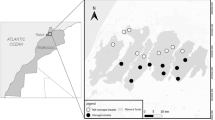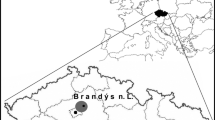Abstract
Small-game hunting is of great economic importance in Portugal. Game managers claim that game management restrictions regarding shoots inside the Nature 2000 Network negatively influence small-game bags, particularly of hare, wild rabbit and red-legged partridge. We analyse whether different habitat and game management practices are associated with game bags of those species in Alentejo (Portugal). Game bag records from five hunting seasons referring to shoots both inside and outside Nature 2000 sites were analysed. Significant differences concerning habitat and game management descriptors were found between shoots inside and outside Nature 2000 sites. However, this ecological network does not seem to correlate with hare and red-legged partridge game bags, whilst it may negatively influence wild rabbit hunting results. Considering that habitat quality for wild rabbit is rather poor inside the studied Nature 2000 sites, further investigation is needed of the possible negative influence of this ecological network on the species’ game bag. Hare game bags increase with extensive non-irrigated agricultural fields and orchards. Besides these two habitats, red-legged partridge game bags are also favoured by cork oak montado where predators are controlled. The game bags of the three small-game species studied increase with hunting effort. Further, our results suggest that there is a positive relation between hunting effort and small-game population abundance.

Similar content being viewed by others
References
Angulo E (2004) Factores que afectan a la distribución y abundancia del conejo en Andalucía. Tesis Doctoral, Universidad Complutense de Madrid (in Spanish)
Borralho R, Carvalho S, Rego F, Pinto PV (1999) Habitat correlates of red-legged partridge (Alectoris rufa) breeding density on Mediterranean farmland. Rev Ecol (Terre Vie) 54:59–69
Buckwell A (2001) The Blues and the Greens: complementarities and conflicts between landowners and environmentalists. Draft scoping paper for the European Landowners Organization (ELO) bureau 5p. Retrieved June 22, 2007, from http://www.elo.org/UserFiles/File/documents/ELO84254.pdf?PHPSESSID=fec04a0b787609fedc99b69ece6
Carvalho JC, Gomes P (2003) Habitat suitability model for European wild rabbit (Oryctolagus cuniculus) with implications for restocking. Game Wildl Sci 20(4):287–301
Dingerkus SK, Montgomery WI (2002) A review of the status and decline in abundance of the Irish Hare (Lepus timidus hibernicus) in Northern Ireland. Mamm Rev 32(1):1–11. doi:10.1046/j.1365-2907.2002.00098.x
Duarte J (2000) Lebre-ibérica (Lepus granatensis) Rosenhaeur, 1856. Galemys 12:3–14
Fernández-Llario P, Mateos-Quesada P, Silvério A, Santos P (2003) Habitat effects and shooting techniques on two Wild Boar (Sus scrofa) populations in Spain and Portugal. Z Jagdwiss 49:120–129. doi:10.1007/BF02190452
Hell P, Flak P, Slamecka J (1997) The correlation between the hunting bag records of red deer, roe deer, and brown hare with those of their primary predators in Slovakia. Z Jagdwiss 43(2):73–84. doi:10.1007/BF02241415
Lombardi L, Fernández N, Moreno S, Villafuerte R (2003) Habitat-related differences in rabbit (Oryctolagus cuniculus) abundance, distribution and activity. J Mammal 84(1):26–36. doi:10.1644/1545-1542(2003)084<0026:HRDIRO>2.0.CO;2
Lucio AJ (1991) Selección de hábitat de la perdiz roja (Alectoris rufa) en matorrales supramediterráneos de la cuenca del Duero. Aplicaciones para la gestión del hábitat cinegético. Ecologia 5:337–353
Lucio AJ, Purroy FJ (1992) Red-legged partridge (Alectoris rufa) habitat selection in northwest Spain. Gibier Faune Sauvage 9:417–429
Maroco J (2003) Análise estatística com utilização do SPSS, 2nd edn. Edições Sílabo Lda, Lisboa
Martín J, Lopez P (2002) The effect of Mediterranean dehesa management on lizard distribution and conservation. Biol Conserv 108:213–219. doi:10.1016/S0006-3207(02)00107-6
Martín J, Salvador A (1995) Microhabitat selection by the Iberian rocky lizard Lacerta monticola: effects on density and spatial distribution of individuals. Biol Conserv 79:303–307. doi:10.1016/0006-3207(95)00110-7
Monzón A, Fernandes P, Rodrigues N (2004) Vegetation structure descriptors regulating the presence of wild rabbit in the National Park of Peneda-Gerês, Portugal. Eur J Wildl Res 50:1–6. doi:10.1007/s10344-003-0027-7
Moreno S, Villafuerte R, Queirós F, Jordán G (1996) Qual é o melhor período do ano para realizar repovoamentos de coelho-bravo (Oryctolagus cuniculus)? Rev Florest 9:267–275
Newsome AE, Parer I, Catling PC (1989) Prolonged prey suppression by carnivores–predator-removal experiments. Oecologia 78:299–309. doi:10.1007/BF00378734
Nyenhuis H (2003) Correlations of beech marten bags with small game bags, forest areas and weather conditions. Forstwiss Centbl 122(6):410–420. doi:10.1007/s10342-003-0009-z
Palomares F (2003) The negative impact of heavy rains on the abundance of a Mediterranean population of European rabbits. Mamm Biol 68:224–234. doi:10.1078/1616-5047-00088
Palomares F, Delibes M (1997) Predation upon European rabbits and their use of open and closed patches in Mediterranean habitats. Oikos 80(2):407–410. doi:10.2307/3546609
Paupério J, Alves PC (2008) Diet of the Iberian hare (Lepus gratensis) in a mountain ecosystem. Eur J Wildl Res 54:571–579. doi:10.1007/s10344-008-0181-z
Reynolds JC, Tapper SC (1996) Control of mammalian predators in game management and conservation. Mamm Rev 26:127–156. doi:10.1111/j.1365-2907.1996.tb00150.x
Reynolds JC, O’Mahony D, Aebischer NJ (2006) Implications of “cyclical” population dynamics for the conservation of Irish hares (Lepus timidus hibernicus). J Zool (Lond) 270(3):408–413. doi:10.1111/j.1469-7998.2006.00147.x
Rivas-Martínez S, Loidi J (1999) Biogeography of the Iberian Peninsula. Itinera Geobot 13:49–67
Rogers PM, Myers K (1979) Ecology of the European wild rabbit, Oryctolagus cuniculus (L.), in Mediterranean habitats. J Appl Ecol 16:691–703
Santos P, Fernández-Llario P, Fonseca C, Capapé A, Bento P, Soares AMVM, Mateos-Quesada P, Petrucci-Fonseca F (2006) Habitat and reproductive phenology of wild boar (Sus scrofa) in the western Iberian Peninsula. Eur J Wildl Res 52:207–212. doi:10.1007/s10344-005-0025-z
Smedshaug CA, Selas V, Lund SE, Sonerud GA (1999) The effect of natural reduction of red fox Vulpes vulpes on small game hunting bags in Norway. Wildl Biol 5(3):157–166
Smith RK, Jennings NV, Harris S (2005) A quantitative analysis of the abundance and demography of European hares Lepus europaeus in relation to habitat type, intensity of agriculture and climate. Mamm Rev 35:1–24. doi:10.1111/j.1365-2907.2005.00057.x
Sokal RR, Rohlf FJ (1995) Biometry, 3rd edn. Freeman, New York
Stahl S, Migot P (1993) L’impacte des prédateurs sur le petit gibier, une revue des enlèvements expérimentaux de prédateurs. In: Migot P, Stahl S (eds) Actes du Colloque Prédation et Gestion des Prédateurs. ONC-UNFDC, Paris, pp 21–35
Tapia L, Dominguez J (2007) Broad-scale habitat use by red-legged partridge (Alectoris rufa) in a low-density area in northwestern Spain. Eur J Wildl Res 53:178–182. doi:10.1007/s10344-006-0079-6
Turner FB, Weaver DC, Rorabaugh JC (1984) Effects of reduction in windblow sand on the abundance of fringe-toed lizard (Uma inormata) in the Coachella Valley, California. Copeia 1984:370–378. doi:10.2307/1445193
Villafuerte R, Calvete C, Gortázar C, Moreno S (1994) First episode of rabbit hemorrhagic disease in free living population of Oryctolagus cuniculus at Doñana National Park, Spain. J Wildl Dis 30:176–179
Weber N, Christophersen T (2002) The influence of non-governmental organizations on the creation of Natura 2000 during the European policy process. For Policy Econ 4:1–12. doi:10.1016/S1389-9341(01)00070-3
Acknowledgements
We thank AFN and ICNB, which made the analysed data available. We are also very grateful to Madalena Barros and Russell Alpizar Jara for their help with figures.
Author information
Authors and Affiliations
Corresponding author
Additional information
Communicated by H. Kierdorf
Rights and permissions
About this article
Cite this article
Paixão, R., Godinho, S. & Santos, P. Is the Nature 2000 Network associated with small-game bag results?. Eur J Wildl Res 55, 553–559 (2009). https://doi.org/10.1007/s10344-009-0274-3
Received:
Revised:
Accepted:
Published:
Issue Date:
DOI: https://doi.org/10.1007/s10344-009-0274-3




